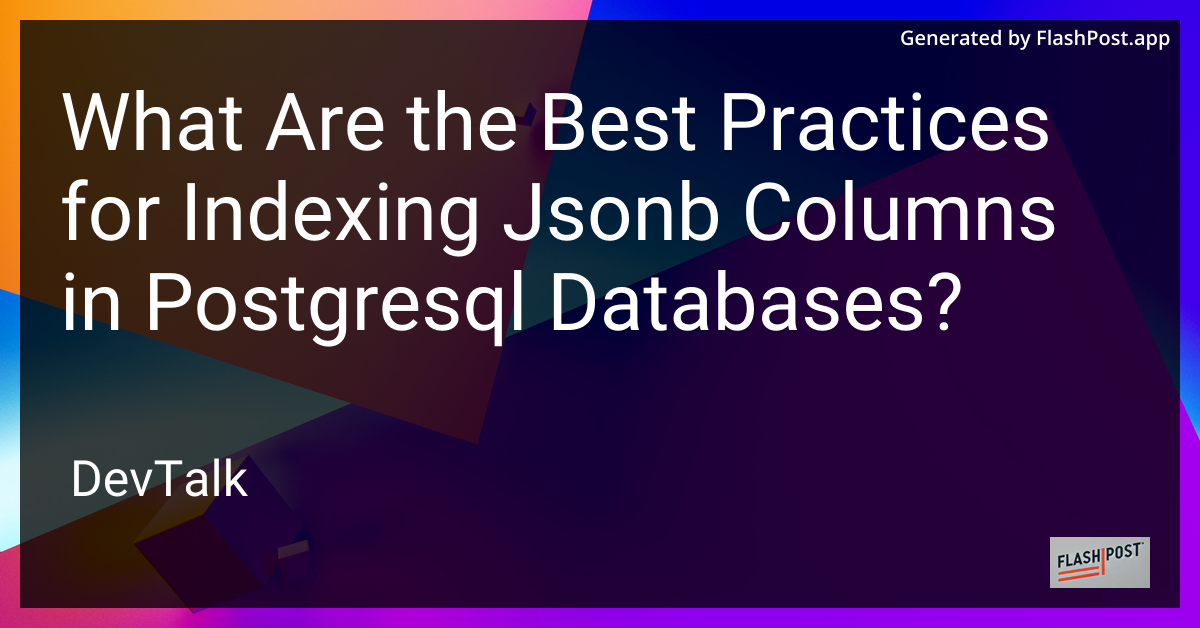What Are the Best Practices for Indexing Jsonb Columns in Postgresql Databases?

Best Practices for Indexing JSONB Columns in PostgreSQL Databases
PostgreSQL's JSONB data type allows you to store semi-structured data in a binary-JSON format, providing flexibility and powerful querying capabilities.
However, effectively indexing JSONB columns is crucial to optimize query performance and resource consumption. In this article, we'll explore the best practices for indexing JSONB columns in PostgreSQL databases, helping you maintain efficiency and speed in your database operations.
Understanding JSONB Indexing in PostgreSQL
Before diving into best practices, let's understand how PostgreSQL handles JSONB indexing. JSONB allows you to store JSON data efficiently and query it with optimized performance. However, due to the flexible and complex structure of JSON data, indexing strategies may vary. Postgres offers several index types that can be used with JSONB columns, including:
- GIN (Generalized Inverted Index): Ideal for full-text search and containment queries.
- BTREE: Suitable for handling smaller and well-structured JSONB documents.
- HASH: Useful for equality comparisons.
Best Practices for Indexing JSONB Columns
1. Use GIN Index for Containment Queries
When you need to perform containment queries (e.g., checking if a JSONB document contains certain key-value pairs), using a GIN index is highly recommended. This index type efficiently handles the @> operator, which checks for containment.
CREATE INDEX idx_jsonb_data ON your_table USING GIN (your_jsonb_column);
2. Partial Indexing for Frequent Queries
If your application frequently queries specific keys within JSONB columns, consider creating partial indexes on these keys. Partial indexing can significantly enhance query speed without the overhead of indexing the entire document.
CREATE INDEX idx_jsonb_key ON your_table USING GIN ((your_jsonb_column -> 'key'));
-- Or for nested keys
CREATE INDEX idx_jsonb_nested ON your_table USING GIN ((your_jsonb_column #>> '{parent_key, child_key}'));
3. Use BTREE Index for Exact Matches
For operations that frequently check for exact matches, such as equality comparisons on specific JSONB keys, a BTREE index can be beneficial. However, remember that BTREE indexes work well only with flat, non-nested data.
CREATE INDEX idx_jsonb_exact ON your_table ((your_jsonb_column ->> 'key'));
4. Regularly Analyze and Maintain Indexes
Regularly running ANALYZE and VACUUM commands on your database helps the query planner make optimal decisions. Keeping your indexes maintained ensures they perform efficiently over time.
VACUUM ANALYZE your_table;
5. Consider JSONB Compression
PostgreSQL automatically compresses JSONB data. However, be mindful of the trade-off between CPU usage for compression/decompression and query performance. Monitor your application's needs to decide the best approach.
Additional Resources
For more insights and techniques on working with JSONB in PostgreSQL, consider exploring the following resources:
- How to Query JSONB Data with PostgreSQL
- How to Order By on a Key Inside JSONB Column in PostgreSQL JSONB
- How to Update Item into the JSONB Data Type Column
- How to Count JSONB Object Keys in PostgreSQL
- How to Export JSONB Column in PostgreSQL
By adopting these best practices and utilizing the recommended resources, you'll be well on your way to optimizing JSONB performance in your PostgreSQL databases. Happy coding!